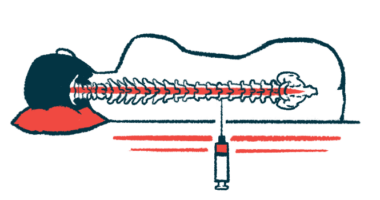Extended treatment with NurOwn may offer additional benefits in ALS
10 patients in expanded access program showed greater reductions in NfL levels

People with amyotrophic lateral sclerosis (ALS) who continued treatment with NurOwn (debamestrocel) after completing a Phase 3 trial experienced additional benefits with extended treatment, data show.
The findings come from 10 adults who received up to six additional doses of NurOwn over nearly one year in an expanded access program (EAP). The patients experienced even greater reductions in neurofilament light chain (NfL) levels, a biomarker of nerve cell damage, after receiving these additional rounds of treatment.
An EAP, also known as a compassionate use program, allows patients with a serious or immediately life-threatening disease to gain access to an investigational treatment outside of clinical studies, when no comparable or satisfactory alternative options are available.
Stacy Lindborg, PhD, shared these data at this year’s ALS Drug Development Summit, held May 21 to 23 in Boston. Her presentation was titled “Promising Longer-Term Biomarker Data from NurOwn Program in ALS: Spotlight on NfL in EAP Extension Cohort.”
“We are very pleased to share these important outcome data from the NurOwn EAP with the ALS community,” Lindborg, a member of the board of directors at BrainStorm Cell Therapeutics, which is developing NurOwn, said in a press release. She previously served as the company’s co-CEO.
Phase 3b study to validate efficacy of NurOwn for mild to moderate ALS
With the go-ahead from the U.S. Food and Drug Administration, the company is planning to launch a Phase 3b study later this year to validate the efficacy of NurOwn in adults with mild to moderate ALS and gather enough data to support an application toward its potential approval.
The two-part study plans to enroll 200 patients who have been experiencing symptoms for less than two years. First, they will be randomly assigned to receive either NurOwn or a placebo for six months along with standard of care. Then, for the next six months, all will receive NurOwn.
To prepare NurOwn, a patient’s blood stem cells are collected and modified in the lab to release neurotrophic factors, or molecules that help nerve cells survive and thrive.
After being grown to hundreds of millions in number, the stem cells are injected into the patient’s spinal canal (intrathecal injection), where they are expected to release enough neurotrophic factors to ease inflammation and prevent nerve cells from dying, thereby slowing disease progression.
The earlier Phase 3 study (NCT03280056), which enrolled 189 adults with rapidly progressing ALS, failed to meet its main goal of slowing disease progression. However, an analysis of a small group of patients who started treatment with less advanced disease showed NurOwn may offer benefits over a placebo.
Eligible ALS participants who received all three intrathecal injections in the Phase 3 trial, including some who had been assigned to a placebo, could then enter an EAP (NCT04681118) and continue receiving NurOwn over two 28-week (six-month) periods.
A total of 10 patients entered the EAP. Eight completed the first period, where they received three doses, and six completed both periods, receiving a total of six doses.
NurOwn significantly lowered levels of NfL in spinal fluid during Phase 3 trial
During the Phase 3 trial, treatment with NurOwn significantly lowered the levels of NfL in the spinal fluid compared with a placebo (by 11% vs. 1.6%), suggesting slower disease progression.
Changes in NfL may predict clinical outcomes, and “the data demonstrate a consistent reduction of neurofilament light (NfL) from baseline [the study’s start] among participants who were randomized to receive NurOwn in the Phase 3 study,” Lindborg said.
Among patients who entered the EAP, NurOwn treatment resulted in a 4% reduction in NfL levels over the Phase 3 trial. However, these patients showed further reductions in NfL levels during the EAP — by 27% after the first period and by 36% after the second period.
On the other hand, patients in the EAP who had initially received a placebo in the Phase 3 study had shown a 37% increase in the NfL levels during the trial. After receiving three doses of NurOwn as part of the EAP, their levels of NfL were 17% higher compared with baseline, and after six doses, they had decreased by 5%.
“These results suggest continual benefit from extended treatment of NurOwn,” the company wrote.
Lindborg said, “We look forward to confirming this finding in the planned Phase 3b study.”








